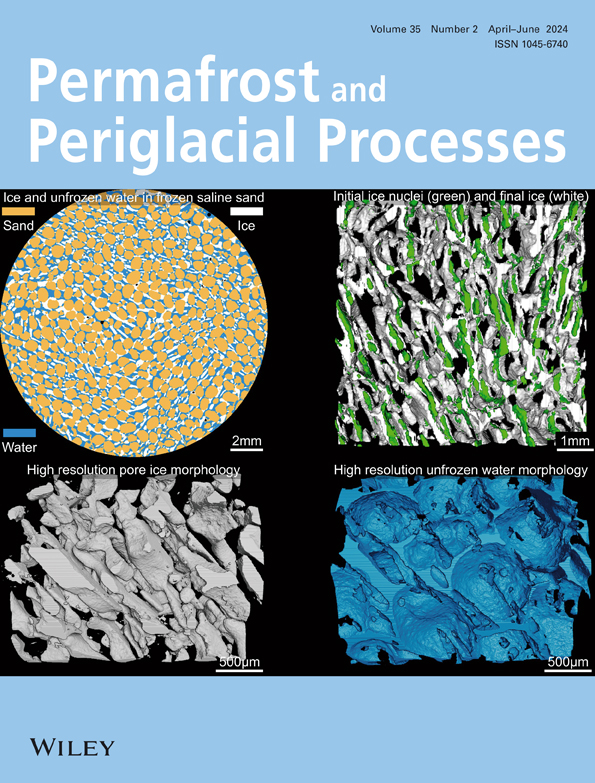阿拉斯加北极山麓基础设施沿线的山坡侵蚀特征和永久冻土动态
IF 3.3
3区 地球科学
Q2 GEOGRAPHY, PHYSICAL
引用次数: 0
摘要
北极丘陵富含冰的永久冻土突然融化,形成了山坡侵蚀特征。在基础设施走廊中,我们观察到路堤附近的热侵蚀和融滑自行愈合。为了进一步了解基础设施和山坡侵蚀特征(INF‐HEF)之间的过程,我们将气候和遥感分析与实地调查相结合,以评估INF‐HEF系统,并在基础设施走廊沿线更广泛的区域验证我们的发现。我们发现,沿着路堤的解冻固结形成了一条热岩溶沟渠,该沟渠在更广泛的研究区域中普遍存在,并受到灌木化的广泛影响,并支持其他正反馈(例如,积雪、蓄水和植被垫减弱)。热岩溶沟渠促进了交叉排水的渠化,从而增加了地形对热侵蚀的脆弱性,热侵蚀在暴雨后演变为融化-坍塌。地形对融滑的恢复力得益于我们场地的地面冰类型和地形。冰楔多边形系统(即互通式土壤和大块冰)中大块冰的横向不连续性,加上具有地形障碍物(如baydzerakhs)的低坡度,降低了滑塌活动,并支持了自稳定。本文章由计算机程序翻译,如有差异,请以英文原文为准。
Hillslope erosional features and permafrost dynamics along infrastructure in the Arctic Foothills, Alaska
Abrupt thaw of ice‐rich permafrost in the Arctic Foothills yielded to the formation of hillslope erosional features. In the infrastructure corridor, we observed thermal erosion and thaw slumping that self‐healed near an embankment. To advance our understanding of processes between infrastructure and hillslope erosional features (INF‐HEF), we combined climate and remote sensing analyses to field investigations to assess an INF‐HEF system and validate our findings in a broader area along the infrastructure corridor. We identified that thaw consolidation along an embankment formed a thermokarst ditch that was ubiquitous in the broader study area, and which was extensively affected by shrubification and supported other positive feedback (e.g., snow accumulation, water impoundment, and weakened vegetation mat). The thermokarst ditch facilitated channelization of cross‐drainage water, thus increasing the terrain vulnerability to thermal erosion that evolved into thaw slumping after heavy rainfalls. The terrain resilience to thaw slumping benefited from the type of ground ice and topography prevailing at our site. The lateral discontinuity of massive ice in an ice‐wedge polygonal system (i.e., interchange soil and massive ice) compounded to a low‐slope gradient with topographic obstacles (e.g., baydzherakhs) decreased slumping activity and supported self‐stabilization.
求助全文
通过发布文献求助,成功后即可免费获取论文全文。
去求助
来源期刊
CiteScore
9.70
自引率
8.00%
发文量
43
审稿时长
>12 weeks
期刊介绍:
Permafrost and Periglacial Processes is an international journal dedicated to the rapid publication of scientific and technical papers concerned with earth surface cryogenic processes, landforms and sediments present in a variety of (Sub) Arctic, Antarctic and High Mountain environments. It provides an efficient vehicle of communication amongst those with an interest in the cold, non-glacial geosciences. The focus is on (1) original research based on geomorphological, hydrological, sedimentological, geotechnical and engineering aspects of these areas and (2) original research carried out upon relict features where the objective has been to reconstruct the nature of the processes and/or palaeoenvironments which gave rise to these features, as opposed to purely stratigraphical considerations. The journal also publishes short communications, reviews, discussions and book reviews. The high scientific standard, interdisciplinary character and worldwide representation of PPP are maintained by regional editorial support and a rigorous refereeing system.

 求助内容:
求助内容: 应助结果提醒方式:
应助结果提醒方式:


